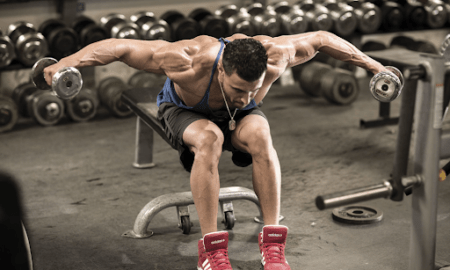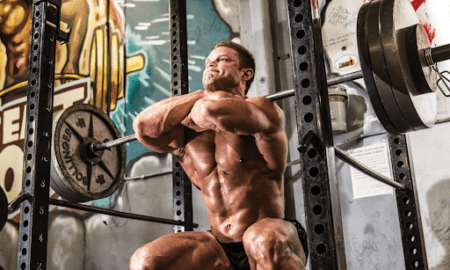Q: I just read one of your columns and was very encouraged by the results you’ve achieved. As an over-40 guy, I’ve been trying to find out what routines I should be using in the gym. My goal is to gain muscle and lose fat—isn’t everyone’s. I’ve been lifting weights the past year using a whole-body routine three times a week. Not only am I bored, but I feel I don’t really have a plan when it comes to workouts and diet. My hope is that you can point me in the right direction. I want to feel like I have a plan and mission each day.
A: You’re absolutely correct when you say you need a plan to make progress in building your physique. Too many individuals do not have a clear plan for what they want to achieve in their workouts, and the result is usually a definite lack of progress.
I think the first thing you should do is ramp up your training routine. You’ve been doing a full-body workout for a year, so I think you can advance to an intermediate training program by adding more exercises for each bodypart.
You could train four days per week, working each muscle group twice a week. It’s almost impossible to train the full body when you’re using two to three exercises for each muscle group. That’s why you split up the bodyparts. Your workouts would be too long and unproductive otherwise.
I recommend two ways to split up the muscle groups. You can train the pushing muscles (chest, deltoids and triceps) in one session and the pulling muscles (back and biceps) plus legs in the next session. That split eliminates the possibility of training similar bodyparts two days in a row because of the separation between pushing and pulling muscles.
Some people don’t like training legs and back in the same workout, however, because those are the two biggest muscle groups. Another way to split is to train chest, back and deltoids at one workout and then legs and arms at the next.
It works well to train the chest and back muscles in the same workout because they’re opposing muscle groups. You work the deltoids indirectly when you train chest and back, so it makes sense to train those muscles in the same workout.
The next training session is legs and arms. The arms are small muscles, so it’s good to include them with leg training, which is typically very demanding and exhausting. It’s much easier to train legs with arms than it is to train legs and back in the same workout.
Here’s an example of how you could structure your program using both splits:
Monday and Thursday:
Chest, back, deltoids and calves
Tuesday and Friday:
Legs, biceps, triceps and abs
Or
Monday and Thursday
Chest, deltoids, triceps and calves
Tuesday and Friday
Legs, back, biceps and abs
Here are two sample workouts using the first split:
Monday
Bench presses 3 x 10, 8, 6
Incline presses 3 x 10, 8, 6
Wide-grip chins 3 x 8-10
Barbell rows 3 x 10, 8, 6
Standing barbell presses 3 x 10, 8, 6
Upright rows 3 x 10, 8, 8
Standing calf raises 3 x 10-12
Seated calf raises 3 x 12-15
Tuesday
Incline situps 2-3 x 40
Incline knee raises 2-3 x 30
Squats 4 x 10, 8, 6, 6
Leg presses 3 x 12, 10, 8
Leg curls 3 x 10, 8, 8
Stiff-legged deadlifts 3 x 10, 8, 8
Close-grip bench presses 3 x 10, 8, 6
Lying extensions 3 x 10, 8, 8
Incline curls 3 x 10, 8, 8
Barbell curls 3 x 10, 8, 6
Now let’s discuss your diet. The key to losing fat and building muscle at the same time is to eat the right number of calories as well as the correct percentages of protein, carb and fat. If you train hard enough and eat correctly, it’s entirely possible to build muscle and lose fat at the same time.
The first step is to eat a minimum of six meals a day. Eating a meal or drinking a protein drink every 2 1/2 to three hours is critical to stimulating the metabolism, keeping blood sugar stable and feeding the muscles the protein they need to maintain a positive nitrogen balance.
Speaking of protein, you need to eat plenty of it to build or maintain lean muscle tissue, even as you’re losing the fat. I’d recommend that you eat approximately 1 1/4 to 1 1/2 grams of protein for each pound of bodyweight. For example, if you weigh 180 pounds, you should be getting 225 to 270 grams of protein per day.
It’s best to choose complete protein foods that are low in fat. Some of my favorites are egg whites, chicken breasts, lean ground turkey, salmon, tuna, round steak and buffalo burgers.
When I can’t eat a whole-food meal, I make sure I get a protein drink made with a high-quality protein supplement. I like a whey protein drink (Optimum Nutrition’s Whey Gold) in the morning or before my workout, a protein supplement consisting of whey, egg and casein protein during the day (Pro Complex from ON) and a casein protein drink before going to bed at night.
It’s important to eat carbs in moderation so you restore muscle glycogen stores and provide the energy for your workouts but, at the same time, starve the fat cells so you lose excess bodyfat. The timing of your carbohydrate intake is critical.
I recommend that you stick with low-glycemic-index, complex carbohydrates like oatmeal, sweet potatoes, whole-grain bread and vegetables. I eat a moderate amount of complex carb at breakfast and lunch but opt for fibrous veggies like broccoli, green beans or asparagus at night. You don’t need complex carbs at night, when you’re getting ready to retire.
It’s also very important to get plenty of fast-digesting carbs and protein immediately after your workout. Studies have shown that taking in a supplement containing whey protein and simple carbs within 15 to 30 minutes after your training session will greatly enhance muscle recovery and growth. I always have two scoops of Optimum Nutrition’s 2:1:1 Recovery and a serving of creatine after I finish a hard training session.
I think a new training program and a strict nutrition program will help you make substantial progress. Set goals for yourself and monitor your progress weekly via measurements to stay motivated and move forward toward your goals.
Q: I have a very important question about fat loss. I’m an advanced weight trainee, and, of course, I don’t use any kind of drugs or even supplements, but I am trying to reduce bodyfat to a single digit: 8 percent. I’m now between 17 and 20 percent. I’m a mesomorph, and I know that type is supposed to lose fat more quickly than endomorphs, but the problem is I get bored and lose motivation. Is it possible for me to lose fat faster than the average person? If so, how fast can I lose fat with my mesomorph body type? I’m doing cardio six days a week on a treadmill at high-to-moderate intensity on an empty stomach first thing in the morning for 30 minutes, and my weight training is two days on/one day off with heavy weights. My diet consists of 55 percent carb, 31 percent protein and 14 percent fat. I take my essential fats from olive oil. My lean body mass is 157.7 pounds, and my current weight is 198 pounds. I’m 5’8”.
A: It’s good that you know what body type you are so you can adjust your diet to make progress; however, body type is just a general guideline, and we all need to make individual adjustments for our bodies due to such other factors as age, activity level and genetics.
I suggest that you cut back on your cardio. Six days a week is way too much. If you have to burn that many calories every day to stay lean, you need to rethink your nutrition program.
I like cardio as a helpful addition to a fat-loss program, but it shouldn’t be the primary method of shedding the fat. Cut the cardio back to three days to begin with. I think you’ll be able to build more muscle on that reduced program and still achieve your lean physique.
Attaining low bodyfat is the result of a superior nutrition program. You need to eat the right amount of nutrients in the correct proportions to feed the muscle cells while simultaneously starving the fat cells and keeping the metabolism stimulated so you don’t hit any plateaus.
You mentioned that your diet is 31 percent protein, 55 percent carbs and 14 percent fat. You didn’t say how many calories you’re eating each day, and that’s an important factor. The first thing I recommend is to change your nutrition program so you’re eating more protein, fewer carbs and more fats. Even if you keep the same number of calories, I think you’d lose bodyfat just by changing the percentages of the macronutrients.
I had to make that change in my own diet several years ago. I used to eat a lot of carbs with moderate protein and low fats. As I got older, I had to change things around so that I ate much more protein and much less carbohydrate.
My off-season diet used to consist of 35 percent protein, 50 percent carb and 15 percent fat. When I dieted for a contest, I would shift it to 40 percent protein, 45 percent carb and 15 percent fat. As long as I kept the calories around 3,000 per day—compared to 4,500 to 5,000 in the off-season—I would consistently lose fat and get ripped for the contest.
My carb intake would be around 250 grams on my off days and 300 to 350 grams on my training days. My protein intake would always stay around 250 grams per day.
Then I cut my carbs back to 150 grams on my nontraining days and 200 grams on my training days. At the same time I increased my protein intake to 320 to 330 grams per day. I also increased my fat intake to approximately 65 to 70 grams per day.
That drastically altered the macronutrient breakdown. On my training days I eat 48 percent of my calories from protein, 30 percent from carbs and 22 percent from fats. On my nontraining days I eat 51 percent of my calories from protein, 24 percent from carbs and 25 percent from fats.
By keeping my protein intake very high and my carbs moderate to low, I was able to consistently lose bodyfat and get harder without sacrificing any muscle tissue. I also increased my fat intake—to 70 grams from 65—on my rest days because my carbohydrate intake was so much lower.
Try the same strategy. I think you’ll see major changes in your bodyfat composition. Also, don’t forget to look at how many calories you’re taking in. You don’t want to eat too few or too many. We’re all individuals, and each of us needs a different number of calories, whether we want to lose, gain or maintain our weight. Good luck!
Editor’s note: John Hansen has won the Mr. Natural Olympia and is a two-time Natural Mr. Universe winner. Check out his Web site at www.NaturalOlympia.com, or send questions or comments to [email protected]. Look for his new DVD, “Natural Bodybuilding Seminar and Competitions,” along with his book, Natural Bodybuilding, and his training DVD, “Real Muscle,” at his Web site or at Home Gym Warehouse, www.Home-Gym.com. Send written correspondence to John Hansen, P.O. Box 3003, Darien, IL 60561. IM




















You must be logged in to post a comment Login